If you’ve ever wondered about the best things to do when buying a Japan Rail Pass, you’re not alone. After plenty of research, reading, and first-hand experience, I’m here to share the essential tips you need to know.
But before we dive into the details, let’s go over the must-know rules—the ones you’ve likely come across in your search but are crucial to highlight again. These rules can make or break your JR Pass experience, so keep them in mind as you plan your trip!
Also Read: What Are The Best Times to Visit Japan: A Traveller’s Guide
1. JR Pass must be bought prior to your arrival in Japan
Looking to buy a JR Pass in Singapore? You’ve got options! You can purchase it physically in Japan, at an authorised travel agent in Singapore, or go for the most affordable route—buying your JR Pass online. Prices vary significantly across retailers, so it’s wise to compare before you commit.
For instance, Changi Recommends, Klook, JTB, and Nippon Travel Agency all offer different rates for the 7-day, 14-day, and 21-day JR Pass. If you’re after the best deal, checking at least three to five online retailers is a smart move. And don’t forget—regional JR Passes might be a better fit depending on your itinerary!
2. There are two types of passes – Ordinary (cheaper) vs Green (premium and expensive)
Here’s a breakdown of the Japan Rail Pass (JR Pass) prices for Green (first-class) and Ordinary (standard-class), for both adults and children:
7-Day JR Pass:
- Green Pass: ¥70,000 (Adult) | ¥35,000 (Child)
- Ordinary Pass: ¥50,000 (Adult) | ¥25,000 (Child)
14-Day JR Pass:
- Green Pass: ¥110,000 (Adult) | ¥55,000 (Child)
- Ordinary Pass: ¥80,000 (Adult) | ¥40,000 (Child)
21-Day JR Pass:
- Green Pass: ¥140,000 (Adult) | ¥70,000 (Child)
- Ordinary Pass: ¥100,000 (Adult) | ¥50,000 (Child)
The Green Pass provides a more luxurious travel experience with spacious seating and added comfort, while the Ordinary Pass is a budget-friendly option for those looking to save on transport costs while exploring Japan. I bought my 7-day Japan rail Ordinary pass for $435.
3. Exchange your voucher for the actual JR pass at the exchange offices when you reach Japan
These exchange offices are usually at the bigger JR stations. The one at Kansai airport has one. Don’t forget to write down the opening hours too. By the way, there are different designs for the Japan rail pass. Mine was the pretty one with Cherry Blossom and Mt Fuji!
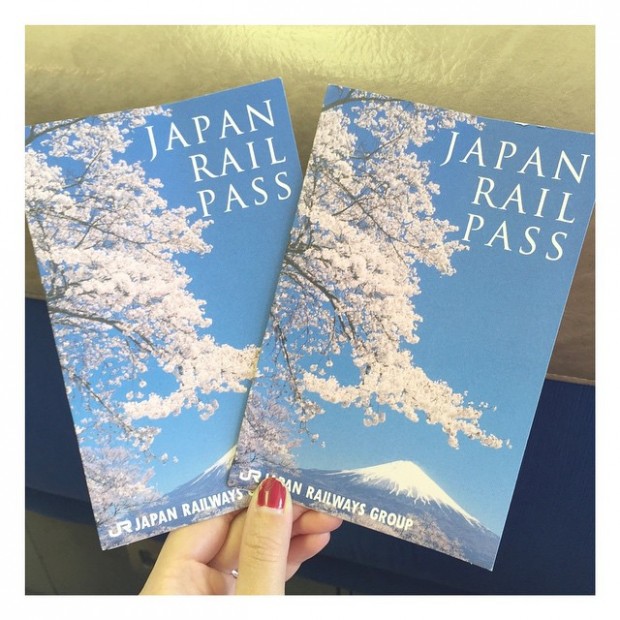
Image Credit: kawaiiyuko
4. JR Pass is not valid for Nozomi/Mizuho trains (the faster trains)
Nozomi trains are regarded to be the most premium and fastest train service as they stop at fewer stops. A trip from Osaka to Tokyo would be about 30 minutes faster if you were on a Nozomi instead of the Hikari. (Follow at your own risk) I tried my luck and took the Nozomi train illegally because I chanced upon the train on the same tracks as my Hikari train which was arriving only 10 to 15 minutes later.
I walked over to the unreserved seats section and managed to get a seat! It was only a 14-minute ride from Shin-Kobe to Shin-Osaka and I took the risk because the unreserved seat carriage was very crowded and I assumed that the train conductor would not have enough time to check my ticket before I arrived at my destination, which was only 14 minutes away!
5. Japan Rail Pass is valid for consecutive days of 7, 14 and 21
You will have to decide on your starting date when you exchange the voucher for your pass. This starting date cannot be changed once the pass is issued.
6. How to read the JR train timetable
It might be a little confusing at first but this timetable would be really useful when you are trying to find out the timings and whether the train that you are on stops at a particular station.
Eastwards means that the train is travelling from left to right (Fukuoka –> Osaka –> Tokyo)
Westwards means right to left (Tokyo –> Osaka –> Fukuoka). Please bookmark the timetable as it may be very useful if you miss your planned train.
Each train will come with an alphabet (N, H, K, S) which determines the train type (Nozomi, Hikari, Kodomo & Sakura) and 3 numbers which equates to the train number. Refer to the yellow box below.
So for example, you would want to travel from Himeji to Shin-Osaka, you will be taking train H478. It will arrive Himeji at 1655 and reach Shin-Osaka at 1740.
If you don’t see any numbers (like the blue portion), it means that the train does not stop at the stations.
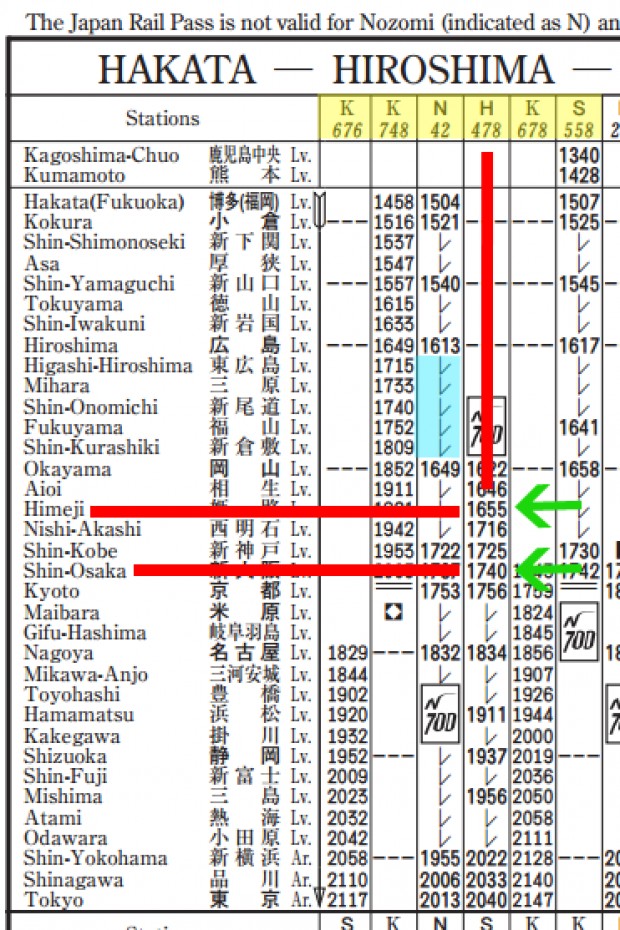
7. Seat reservations are free and it is highly encouraged
If you own a JR Pass, seat reservations are free, and they can be made at any JR office (usually green signboard) at the bigger station. Window seats are usually highly sought after and I always request for the side where I can see Mt Fuji. Although some websites say that seat reservations are optional, especially during non-peak timings, it is highly encouraged especially for long train rides. Imagine standing 3 hours on the train..
To reserve your seat, you will need to inform the staff at the JR office of your departure and arrival station, and train number (if you know). They will then scan through the rows to see if your preferred seat (usually window) is available. After which, they will print out a ticket which looks like the image below (top). It will contain the train departure timing (7:26), Train Number (Hikari 510), Train Car Number (13) and Seat Number (3-D).
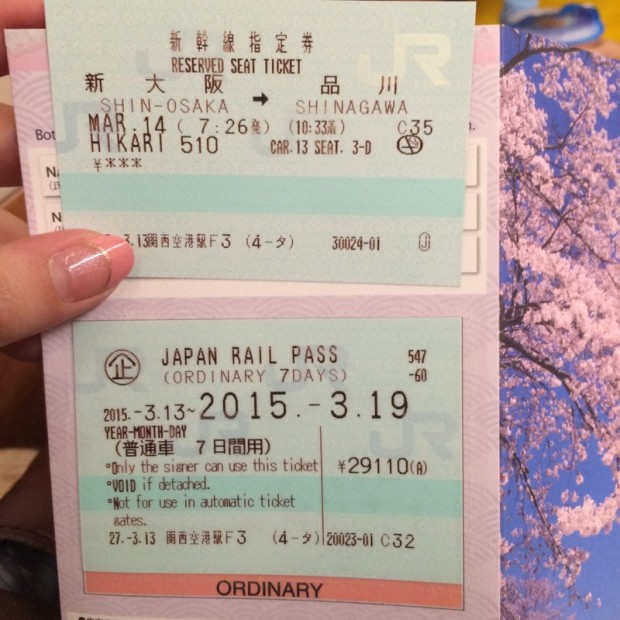
8. Shin-Osaka is not Osaka; Shin-Kobe is not Kobe Station
The names can be very very very confusing at times. Usually, if you take the Shinkansen, they will usually stop at the “Shin-X” stations as “Shin” stands for “New” in Chinese. I guess they can’t be bothered to think of a name for the newer major stations, thus they added the “Shin” in front. Though not always true, the “Shin” stations are often not located within walking distance of the non-Shin Stations. For Osaka, Shin-Osaka and Osaka stations are about 2 stations away.
9. How to board the train and where to queue
Step 1: Go to hyperdia and set your start and end station. If the station that you are at has more than 2 tracks, usually the track that you have to be at would be indicated. In this case, you will arrive at Osaka Station and track No.2 and you need to be at track No.5 to board the 10:00 train which would bring you to Himeji at 11:02.
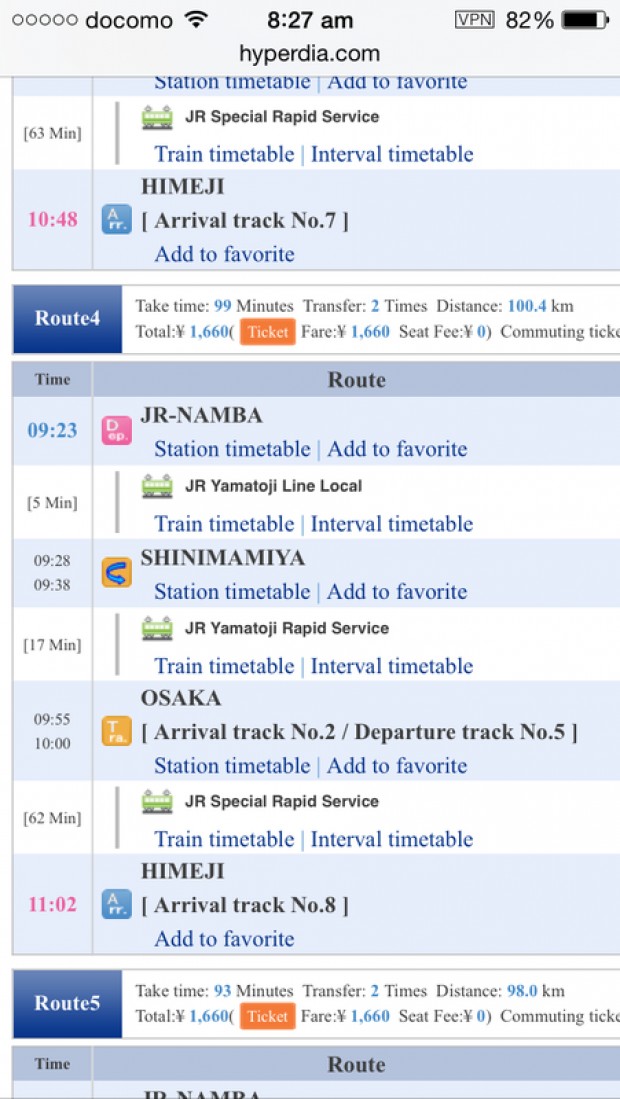
Locate the directional signs and walk towards track 5. Okay, the picture is not a good example but let’s try. As you can see, the timing of the arrival of the train (provided that you are not at the first stop) will be indicated. The indications of Circle (O) and Triangle (^) indicate the queue line. The numbers 5~10 or 1~7 or sometimes 1~10 indicate the carriage number of the train. Some trains are shorter, while others are longer. If you are holding a ticket for a reserved seat, you should proceed to the number and queue behind the Circle or the Triangle.
Also, use the clock to check the current timing as the train is usually on time.
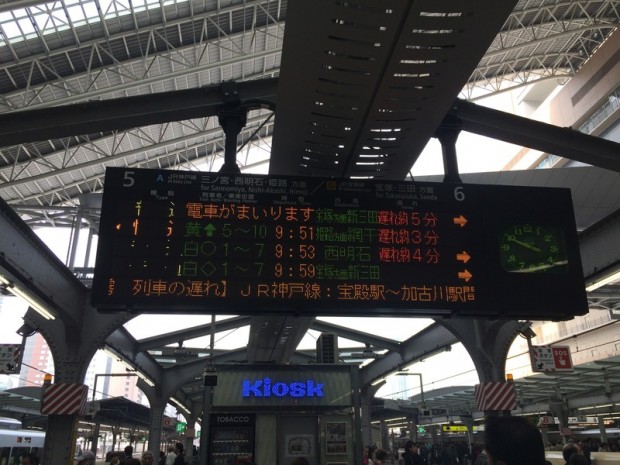
Look below, number 5 represents the carriage number while the triangles and circles indicates where you should queue at. Why is there a need for such symbols on the ground? This is because one train track can support multiple trains traveling towards multiple destinations. Often, the interval of these trains are very close and the traffic is very high. Thus, these small indications help to control the queue line to allow for quicker boarding.
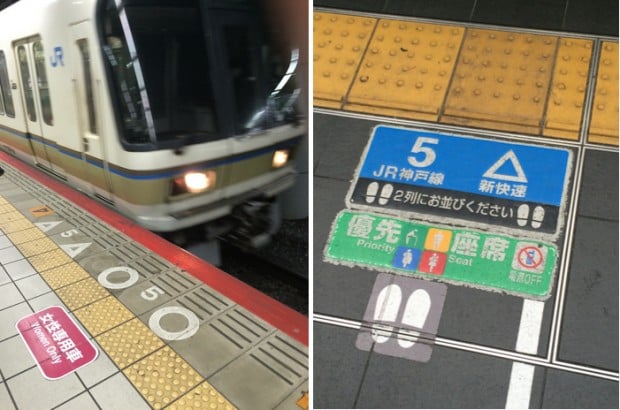
10. JR Pass – the final decision
To determine whether JR Pass IS essential to your trip or not, you will have to work out the FINE DETAILS with exact cost estimations for all your travel plans.
Let’s take my itinerary to analyse the value of my JR Pass.
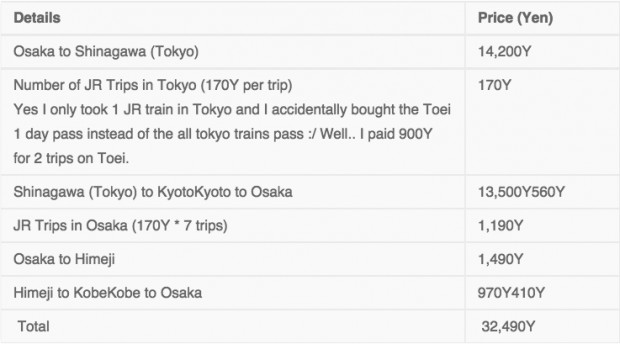
Right, so I had a cost savings of ¥3,380 which equates to $22.40. The prices I listed above are based on the 2015 pricing. To be honest, my decision to explore Himeji and Kobe despite my super rush itinerary was partly fueled by my kiasu syndrome because I bought the JR Pass.
Nevertheless, I don’t regret my Himeji trip because the castle is so so so beautiful, even if it is just staring at the main building from the outside.
Also Read: Is the Japan Rail Pass worth it?
11. Train Bento
Everyone has been talking about the MUST TRY TRAIN BENTO which looks really cool, especially when you’re eating it on the train but I’m here to burst your bubble – it ain’t as delicious as it looks.
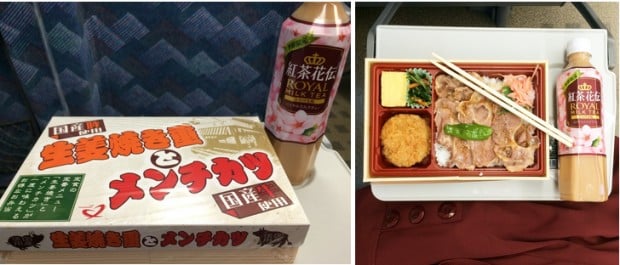
MAYBE I have chosen a not so delicious box but cold food is definitely a NO for me. I have no idea how on earth I had gotten the misconception that such bento bought from the train stations prior to the trip would be served hot. I chose this box for the croquette and the beef slices but eating such food at like 15 to 20 degree Celsius is definitely not appetising. Moreover, the disappointment is multiplied because I paid so much for it.
On my next train journey, I ate a simple crepe or onigiri (triangle sushi).
12. The train conductor
Having sat on various long train rides in different countries, I realise that every train conductor has a different way of checking the tickets. For reserved seating, it’s a little easier as the train conductor would have a list of who are the new customers that have just boarded the train. They will then request to check your tickets (only once) and then not bother you again if you get off at the correct stop. Assigned seating must be strictly adhered to.
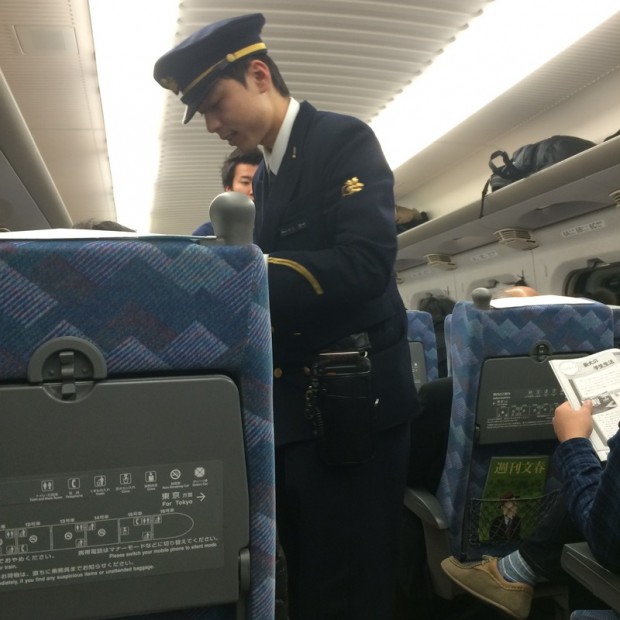
Only in Japan, would you see young and dashing individuals working as train conductors. Perhaps it was the pilot-looking uniform which added brownie points. Anyway, they are really polite in their actions and gestures. They make it a point to bow to the entire carriage before they enter and/or leave. Customer service is definitely a super plus point for them!
13. Perks of the JR train
If you are sitting at the window seat, don’t forget that there are hooks which you can use to hang your coats and scarf. Similar to the aeroplane, there’s a fold-down table which you can use for eating/writing comfortably. The seats are also able to be inclined backwards for about 30 degrees (estimation). However, there are times where I feel comfortable enough and did not incline my seat for the entire journey.
Yes – power supply exists on the train! If you don’t have a portable battery, don’t forget to bring your powerpoint charger and traveller adapter to add that juice to your battery. Didn’t get a chance to test it out but I think it should work.
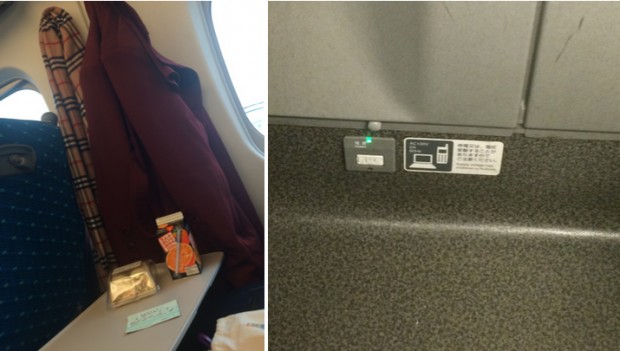
14. In Tokyo, if you plan to buy the 1-day pass…
Please research properly on the type of pass that you require, the places that it is sold at, and the price of the ticket. In my case, I wanted to purchase the 1 Day Pass which allows me unlimited rides on Tokyo Metro, Toei Subway and even the Odaiba line. I was supposed to purchase 1 Day Tokyo pass (Tokyo Metro + Toei Subway) which cost ¥1,000. If I kept to my planned itinerary of visiting Tsujiki Market, Gion, Yasukuni Shrine, Suidobashi, Skytree to Shimbashi, and Odaiba within 1 Day, I would utilise ¥1,070 which justifies the purchase.
HOWEVER, for whatever reason, the 1 Day Tokyo Pass at ¥1,000 option did not appear in the ticketing machine at Sengakuji (Toei Line). All I saw was a ¥900 option and a ¥1,150 or ¥1,100 option. I tried to speak to the ticketing office but he directed me to the machine. Although the “English” option exists, clicking on it only changes the title of the menu, and not the choices. So, I bought the ¥900 option (stupidly thinking that the ticket got cheaper) because it had the word 东京 (which meant Tokyo).
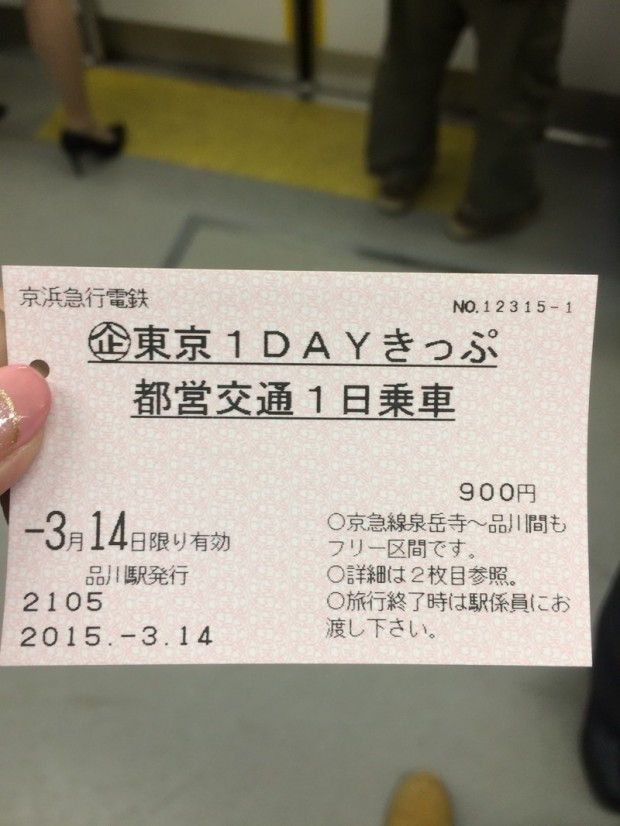
Sadly, my ticket turned out to be valid only on Toei subway and I ended up paying ¥170 more for an unplanned transfer using Tokyo Metro.
I eventually ended up using only ¥720 of the Toei subway pass.
Had to pay an additional ¥720 for a 2-way for Odaiba.
I had JR Pass too and took a few JR trains..
All in, I spent ¥1,790 on transport for a 22 hours Tokyo escapade and forsake Yasukuni Shrine + Skytree due to lack of time.
CONCLUSION: the unlimited day passes might not be worthwhile after all! It is cool and idealistic to pack your itinerary but in reality, it is hard to gain back the “worth”. There are simply too many distractions in Tokyo (Japan) and it’s hard to stick to very right plans. The next time I go, I think I’m just gonna stick with single ticket fare every trip.
15. Trains do not stop at every stop
When I was in Osaka, a journey that was supposed to take me 15 minutes took me almost an hour. I was supposed to travel from Osaka Station to JR Namba Station. If I had not purchased the JR Pass, I would have paid 220Y and taken the Midosuji Line and it would have been 4 stops, without any transfer.
HOWEVER, owning the JR Pass would mean that I have to take the JR lines as it would be FREE. Thus, I had to take the JR Osaka Loop Line which would involve one transfer. I don’t know why I was so blurred that night (10-11 pm) but I took the wrong direction of the Loop Line. Loop Line is very tricky as it runs in a circle so how on earth do you know which direction it moves in? So, when I finally realised that I was moving in the wrong direction I was like fine.. I shall just ride the entire loop to my destination. And then suddenly, like 3 stops later, there was a lot of announcement by the train driver and the train stopped at a station and everyone left the train.
Apparently the reason why the trains were stopping so randomly was because they were ending their service for the day. So I left the train and pondered on whether I should cross and find the other platform for the loop train which would travel in the opposite direction (which was the initial correct direction) or wait for the next train. In the end, I walked down the platform and walked back up the same platform, deciding to stick to the same direction, in case the train in the opposite direction stopped randomly and did not bring me to my destination.
(At that time, I was wondering what would happen to me if I kept boarding the wrong trains and never got to my destination before the train service ended for the night. Will I be walking all the way back to my accommodation or spend a huge bomb on the super expensive taxis in Japan?)
If I’m not wrong, it was a more than 10 minutes wait for the next train (While in Singapore we complain if we see a 6 minutes wait for the next train). Right. So I boarded another loop train, hoping that it will not stop randomly again.
Thankfully, I managed to transfer to the JR Yamatoji Line and reach JR Namba successfully. When I reached my accommodation (after a supermarket shopping spree), my friends who took the Midosuji route arrived 30 minutes earlier than me..
trains, trains, trains, you are so helpful but your timings, varieties, and possibilities scare the shit out of me. honestly, if I didn’t have a data connection, I think I might just remain lost forever.
Also Read: 16 Things Japan Does Better Than Your Country
Hope the train tips help, in some way or another. Do feel free to share other tips which you may know of.
If I am free in the weeks to come, I will write a full entry on how confusing Tokyo trains are. It’s complexity is seriously no joke and I suspect even Japanese themselves are equally confused.
Contributed by Follow My Footsteps x Flyhoneystars




